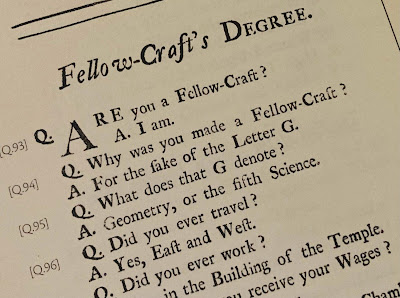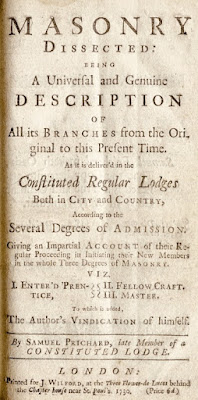Thank you for reading The Magpie Mason. Today, we begin our fifteenth year together.
Publicity Lodge 1000 returned from its Summer Refreshment on Monday the twelfth, beginning a new year of Masonic labor. The Magpie Mason was scheduled to present a discussion of Masonic educational value, so, with a Ceremony of Passing on the trestleboard for an upcoming meeting, I chose the Fellow Craft Degree as that topic of conversation. And not just any second degree, but the one printed in 1730 by one Samuel Prichard in his essential ritual exposure Masonry Dissected, newly published by the Masonic Book Club. Masonic rituals, Masonic lodges, Masonic grand lodges, Masonic everythings were very different 300 years ago. All of it was very basic compared to what we have today.
I explained how when Masons think of lodges, we understandably envision the modern lodge room, with its varied furniture, seating arrangement, equipment, décor, etc., but things were primitive in the early eighteenth century when lodges met in tavern dining rooms or in private homes. There were no tall pillars flanking the Inner Door (there was no Inner Door!), and instead the brethren spoke ritually of J and B, explaining their purposes and describing their looks, using language similar enough to what we know today.

I told the lodge I was going to read the ritual of the degree. Read the ritual?! That could take hours! Yet the ritual of that period was very basic as well, consisting of a call-and-response dialog among the Worshipful Master and the brethren (not unlike our current Opening and Closing rituals) that spans only five pages of the MBC edition. The Fellow Craft Degree of 1730 included no elaborate floor work, no lengthy monolog lecture or other ceremonious orations, no hoodwink, nor other elements we today expect. Some of those features already were revealed to the candidate during the “Enter’d ’Prentice’s Degree,” and so went forsaken in the second degree. Anyway, reading the entire “Fellow-Craft’s Degree” ritual required only a couple of minutes. I won’t transcribe it all here, but do recommend to you the new book from the MBC. They will have more copies for sale after the subscription sales have been satisfied. (I saw Lewis Masonic had it listed for sale the other day, but it seems to be gone from their website now.)
Unsurprisingly, the letter G is very significant to the degree. I’ll share this brief passage. It rhymes and is in question-and-answer form. The dialog is between the Master and different brethren in the lodge (not the candidate, who wouldn’t be capable of answering), so you really had to know your ritual because you wouldn’t know which answers you’d be expected to recite on any given evening.
Q. Can you repeat the letter G?
A. I’ll do my endeavor. In the midst of Solomon’s Temple there stands a G, a letter fair to all to read and see, but few there be that understands what means that letter G.
Q. My friend, if you pretend to be of this fraternity, you can forthwith and rightly tell what means that letter G.
A. By sciences are brought to light bodies of various kinds, which do appear to perfect sight, but none but males shall know my mind.
Q. The Right shall.
A. If Worshipful.
Q. Both Right and Worshipful I am, to hail you I have command, that you do forthwith let me know, as I you may understand.
A. By Letters Four [the Word of EA] and Science Five [the fifth science, Geometry] this G aright does stand, in a due art and proportion, you have your answer, friend.
Q. My friend, you answer well, if Right and Free Principles you discover, I’ll change your name from friend, and henceforth call you Brother.
A. The Sciences are well composed of noble structure’s verse, a Point, a Line, and an Outside, but a Solid is the last.
Q. God’s good greeting be to this our happy meeting.
A. And all the Right Worshipful Brothers and Fellows.
Q. Of the Right Worshipful and Holy Lodge of St. John’s.
A. From whence I came.
Q. Greet you, greet you, greet you thrice, heartily well, craving your name.
A. (Candidate gives his name.)
Q. Welcome, Brother, by the grace of God.














































































